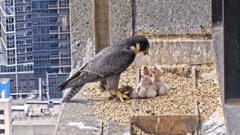What Makes the Nestflix Peregrine Falcon Livestream So Addictive for Australians?

Published: 2025-11-08 03:00:27 | Category: technology
Since the end of August, a remarkable reality show known as "Nest-flix" has captivated tens of thousands of Australians, showcasing the dramatic lives of peregrine falcons residing atop a Melbourne skyscraper. This unique channel, which gained popularity during the Covid pandemic, offers viewers an unfiltered glimpse into the falcons’ world, complete with airborne fights, births, and their much-anticipated first flights.
Last updated: 06 October 2023 (BST)
What’s happening now
The excitement surrounding the peregrine falcons at 367 Collins Street is reaching a fever pitch as fans await the fledging of this year’s chicks. The hatchlings, which began emerging in late September, are currently testing their wings on the 34th-storey ledge. Their mother, a formidable hunter, has been seen flying past with pigeons, encouraging her chicks to take their first leap into the world. Dr Victor Hurley, founder of the Victorian Peregrine Project, highlights the significance of this moment, noting how the mother’s behaviour is a natural method to coax the chicks into flight.
Key takeaways
- "Nest-flix" has become a phenomenon, attracting large audiences to witness the lives of peregrine falcons.
- The chicks are expected to take their first flights within days, with the male likely to lead the way.
- Peregrine falcons have made a significant recovery in Australia since the 1980s, despite ongoing challenges.
Timeline: how we got here
The journey of the peregrine falcons at 367 Collins Street has evolved significantly over the years:
- 1991: Dr Victor Hurley discovers the nesting site and establishes the Victorian Peregrine Project.
- 1991: Initial nesting attempts fail due to poor conditions in a metal gutter.
- 1993: Installation of a nest box leads to the successful hatching of three chicks.
- 2017: Live streaming of the nest begins on YouTube, later evolving into "Nest-flix".
- 2023: Current chicks hatch, with fledging expected soon.
What’s new vs what’s known
New today/this week
As of early October, viewers are eagerly anticipating the first flights of this year's chicks. The male chick is expected to be the first to soar, with his sisters likely following a week later. This event has heightened excitement among the online community tracking these birds.
What was already established
Previously, the falcons have faced various challenges, including territorial battles and struggles for survival. The history of the peregrine falcon population in Australia has shown a remarkable recovery since the banning of harmful pesticides in the 1980s, leading to their presence in urban environments.
Impact for the UK
Consumers and households
While the peregrine falcons are a significant ecological presence in Australia, their story resonates in the UK, where similar raptor species can also be found. The interest in wildlife and the dynamics of urban ecosystems have parallels in the UK, where urban wildlife is increasingly being monitored and celebrated.
Businesses and jobs
The popularity of "Nest-flix" has implications for local businesses, particularly those in tourism and wildlife observation. This phenomenon highlights the potential for ecological tourism and the economic benefits that can arise from engaging communities with local wildlife.
Policy and regulation
Conservation efforts for raptors and other wildlife are crucial in both Australia and the UK. The success of the peregrine falcons can inform policy decisions regarding urban wildlife habitats and the importance of preserving natural ecosystems amidst urban development.
Numbers that matter
- 389 km/h: Speed at which peregrine falcons can dive, making them the fastest animals on earth.
- 60%: Mortality rate for peregrine falcon chicks in their first year, highlighting the challenges they face.
- 50,000: Members of the Facebook fan page dedicated to the Melbourne falcons, showcasing community interest.
Definitions and jargon buster
- Peregrine Falcon: A bird of prey known for its incredible speed and agility.
- Fledging: The process where young birds leave their nest and learn to fly.
- DDT: Dichlorodiphenyltrichloroethane, a pesticide that was banned due to its harmful effects on wildlife.
How to think about the next steps
Near term (0–4 weeks)
As the chicks prepare to fledge, observers should monitor their behaviour closely. The timing of their first flights is crucial for their survival, and conditions can vary significantly.
Medium term (1–6 months)
Post-fledging, the chicks will need to establish territories and learn to hunt. Tracking their movements could provide insights into their survival rates and adaptation to urban environments.
Signals to watch
- Dates of expected fledging, particularly the first flight of the male chick.
- Behavioural changes in the chicks as they prepare for independence.
- Community engagement and updates from wildlife groups monitoring the falcons.
Practical guidance
Do
- Follow the live stream of "Nest-flix" for real-time updates on the falcons.
- Participate in community discussions about wildlife conservation.
- Engage with local wildlife projects to learn more about urban wildlife.
Don’t
- Interfere with nesting birds or their habitats.
- Assume all wildlife behaves in the same way; every species has unique needs and behaviours.
- Neglect the importance of conservation efforts; they are vital for sustainability.
Checklist
- Keep binoculars handy for observing local wildlife.
- Stay updated on local wildlife events and talks.
- Encourage friends to join wildlife observation communities.
- Learn about local raptor species and their conservation status.
- Support local businesses that promote wildlife tourism.
Risks, caveats, and uncertainties
While the current focus is on the chicks' imminent fledging, it is important to recognise the inherent risks involved in their survival. Factors such as poor weather conditions, predation, and human interference can significantly impact their chances. The recovery of peregrine falcons is a success story, but ongoing challenges remain, particularly in urban settings.
Bottom line
The narrative of the peregrine falcons at 367 Collins Street is one of resilience and adaptation. As the chicks prepare for their first flights, they embody the challenges faced by wildlife in urban environments. Observers are not just watching a spectacle; they are witnessing a vital part of nature's cycle. The success of these falcons serves as a hopeful reminder of the importance of biodiversity in our cities.
FAQs
What is "Nest-flix"?
"Nest-flix" is a live-streaming channel that showcases the dramatic lives of peregrine falcons nesting atop a Melbourne skyscraper, attracting a significant online audience.
When will the peregrine falcon chicks first fly?
The male chick is expected to take its first flight shortly, possibly as early as this weekend, with the female chicks likely following within a week.
Why are peregrine falcons important to urban ecosystems?
Peregrine falcons help control pigeon populations and serve as indicators of urban biodiversity, showcasing adaptation to city life.



